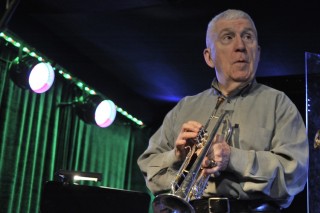Title
Subhead

Moscow-bred Valery Ponomarev will help the Juilliard Jazz Ensembles explore the music of Clifford Brown, Max Roach, and Art Blakey.
(Photo by Galina Ryabokon) More Photos »It is hard to overestimate the importance of drummers Art Blakey and Max Roach in the mid-’50s expansion of the jazz idiom. Of the components that are central to jazz, rhythmic acuity ranks as highly as the ability to improvise, and both Roach and Blakey were ace timekeepers who expanded jazz rhythms by introducing myriad subtleties—some melodic—into the timekeeper’s art. Both were also bandleaders at a time when it was still a novelty for drummers to be calling the shots. The seminal ensembles they assembled in the ’50s, both of which advanced jazz’s stature on the world stage, are the subject of Lightning, Thunder and Fire: The Sophistication of the Clifford Brown-Max Roach Quintet and Art Blakey and the Jazz Messengers. This concert by the Juilliard Jazz Ensembles takes place on December 9 in Paul Hall under the direction of guitarist and faculty member Rodney Jones and guest coach Valery Ponomarev. Moscow-born trumpeter Ponomarev played with Blakey for many years, as did Wynton Marsalis (’81, trumpet), the director of Juilliard Jazz, who joined the Jazz Messengers at the age of 19.
Body
What made both groups so groundbreaking will be evident in the evening’s repertoire, which gets at the development of jazz as a composer’s music. The idiom’s modernist movement, called bebop, was still in full swing when both groups were making their first recordings in 1954-55, but where the modern jazzers of the late ’40s were often building on the harmonies of earlier popular songs by songsmiths like Cole Porter or Jerome Kern, Roach and Blakey were part of a wave that encouraged the composition of burnished tunes that were jazz-specific both rhythmically and harmonically. As a result, the term bebop was soon supplanted by the seemingly unyielding title hard bop, a nickname that suggested an entire scene of likeminded individuals doubling down on bluesy grooves. In the December 9 concert, jazz’s maverick streak is revisited during the Roach half of the evening, as the ensemble plots the distance between the Brown-Roach Quintet’s historic re-evaluation of Porter’s “I Get A Kick Out Of You”—a 1934 pop tune the fivesome stretched to the breaking point—and its introduction of “Joy Spring,” a lilting piece composed by the group’s co-bandleader, the trumpeter Clifford Brown.
Though Blakey and Roach enjoyed long, prolific careers, the half of the concert devoted to Blakey’s work reveals a key difference between the two icons. The Brown-Roach Quintet met an abrupt end in 1956 with the tragic car accident that killed Clifford Brown and pianist Richie Powell, but Blakey (one of whose nicknames was Thunder—hence the title of the concert) turned the Jazz Messengers into one of the most enduring small-group concepts in jazz, energized by the steady stream of young talent he handpicked until his own death in 1990. The ensemble functioned as a jazz finishing school before there were jazz education programs, which explains why the tunes selected for the December 9 concert (among them saxist Benny Golson’s “Along Came Betty,” trumpeter Lee Morgan’s “Kofo’s Waltz,” and Wayne Shorter’s “Sincerely Diana”) are among the first classics written by a veritable who’s who of musicians who penned them as Jazz Messengers; all of them would later become icons in their own right. Nurtured by one of the greatest talent enablers in jazz history, they came by their sophistication in a way that many would agree no longer exists.






